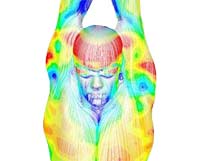This year, major sporting events such as the Winter Olympics in Turin (Italy) and the 2006 World Cup in Germany have become “high-tech stages.” The next destination for the tech world will be the 2008 Olympics in Beijing.
 |
|
Supercomputers analyze the flow around the athlete’s body. Photo: Speedo |
In preparation for the upcoming Olympics in two years, the leading American sportswear manufacturer Speedo has been developing a plan to use supercomputers to create the next version of their famous Fastskin swimsuit.
Speedo reports that currently, most swimmers wear fitted suits. Some prefer to cover their wrists and ankles, while others do not want sleeves, and many prefer suits that only reach the knee. The company has catered to all these needs but wants to delve deeper into how the design of the swimsuit affects an athlete’s speed.
The research data collected by Speedo is analyzed using the Fluent Computational Fluid Dynamics (CFD) program directly on the high-performance SGI Altix supercomputer at the Speedo Aqualab.
The CFD displays the flow paths of the currents emanating from the athlete’s body and around the Fastskin material, which is designed to mimic shark skin with small ridges on the surface. Speedo has observed that water flow during swimming is more significant for female swimmers than for male swimmers; therefore, the designs for the two genders will differ significantly.
Barry Bixler, a key member of Aqualab, stated that thanks to Fluent CFD, he can conduct deeper analyses and address various issues related to drag while swimming. “We are interested in the speed and direction of the flow, where it originates from the body, when the currents intersect, and the intensity of the frictional forces,” Bixler explained.
Bixler also believes that athletes can swim faster when wearing longer suits, as they help regulate the flow around their bodies and reduce drag.


















































